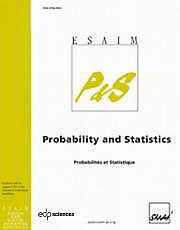Crossref Citations
This article has been cited by the following publications. This list is generated based on data provided by
Crossref.
Sarajlić, Anida
Janjić, Vuk
Stojković, Neda
Radak, Djordje
Pržulj, Nataša
and
Fraternali, Franca
2013.
Network Topology Reveals Key Cardiovascular Disease Genes.
PLoS ONE,
Vol. 8,
Issue. 8,
p.
e71537.
Kuo, Chia-Tung
Walker, Peter B.
Carmichael, Owen
and
Davidson, Ian
2014.
Spectral Clustering for Medical Imaging.
p.
887.
İnkaya, Tülin
2015.
A parameter-free similarity graph for spectral clustering.
Expert Systems with Applications,
Vol. 42,
Issue. 24,
p.
9489.
Anis, Aamir
El Gamal, Aly
Avestimehr, Salman
and
Ortega, Antonio
2015.
Asymptotic justification of bandlimited interpolation of graph signals for semi-supervised learning.
p.
5461.
Klopotek, Mieczyslaw
Wierzchon, Slawomir
Borkowski, Piotr
and
Sydow, Marcin
2016.
Applications of Discrete Dirichlet Problem to Semi-supervised Community Detection by Label Propagation.
p.
224.
García Trillos, Nicolás
and
Slepčev, Dejan
2016.
Continuum Limit of Total Variation on Point Clouds.
Archive for Rational Mechanics and Analysis,
Vol. 220,
Issue. 1,
p.
193.
Thiagarajan, Jayaraman J.
Sattigeri, Prasanna
Ramamurthy, Karthikeyan Natesan
and
Kailkhura, Bhavya
2016.
Robust Local Scaling Using Conditional Quantiles of Graph Similarities.
p.
762.
Zang, Wenke
Jiang, Zhenni
and
Ren, Liyan
2017.
Improved Spectral Clustering Based on Density Combining DNA Genetic Algorithm.
International Journal of Pattern Recognition and Artificial Intelligence,
Vol. 31,
Issue. 04,
p.
1750010.
Karasuyama, Masayuki
and
Mamitsuka, Hiroshi
2017.
Adaptive edge weighting for graph-based learning algorithms.
Machine Learning,
Vol. 106,
Issue. 2,
p.
307.
Sakaridis, Christos
Drakopoulos, Kimon
and
Maragos, Petros
2017.
Theoretical Analysis of Active Contours on Graphs.
SIAM Journal on Imaging Sciences,
Vol. 10,
Issue. 3,
p.
1475.
Cornillon, P.-A.
Gribinski, A.
Hengartner, N.
Kerdreux, T.
and
Matzner-Løber, E.
2018.
Nonparametric Statistics.
Vol. 250,
Issue. ,
p.
1.
Anis, Aamir
El Gamal, Aly
Avestimehr, A. Salman
and
Ortega, Antonio
2019.
A Sampling Theory Perspective of Graph-Based Semi-Supervised Learning.
IEEE Transactions on Information Theory,
Vol. 65,
Issue. 4,
p.
2322.
Sakaridis, Christos
Kolotouros, Nikos
Drakopoulos, Kimon
and
Maragos, Petros
2019.
Processing, Analyzing and Learning of Images, Shapes, and Forms: Part 2.
Vol. 20,
Issue. ,
p.
149.
Zhang, Xian-Da
2020.
A Matrix Algebra Approach to Artificial Intelligence.
p.
223.
Jaffe, Ariel
Kluger, Yuval
Linderman, George C.
Mishne, Gal
and
Steinerberger, Stefan
2020.
Randomized near-neighbor graphs, giant components and applications in data science.
Journal of Applied Probability,
Vol. 57,
Issue. 2,
p.
458.
Tan, Malong
Zhang, Shichao
and
Wu, Lin
2020.
Mutual kNN based spectral clustering.
Neural Computing and Applications,
Vol. 32,
Issue. 11,
p.
6435.
Liu, Zijing
and
Barahona, Mauricio
2020.
Graph-based data clustering via multiscale community detection.
Applied Network Science,
Vol. 5,
Issue. 1,
Zamiri, Mona
and
Sadoghi Yazdi, Hadi
2021.
Image annotation based on multi-view robust spectral clustering.
Journal of Visual Communication and Image Representation,
Vol. 74,
Issue. ,
p.
103003.




